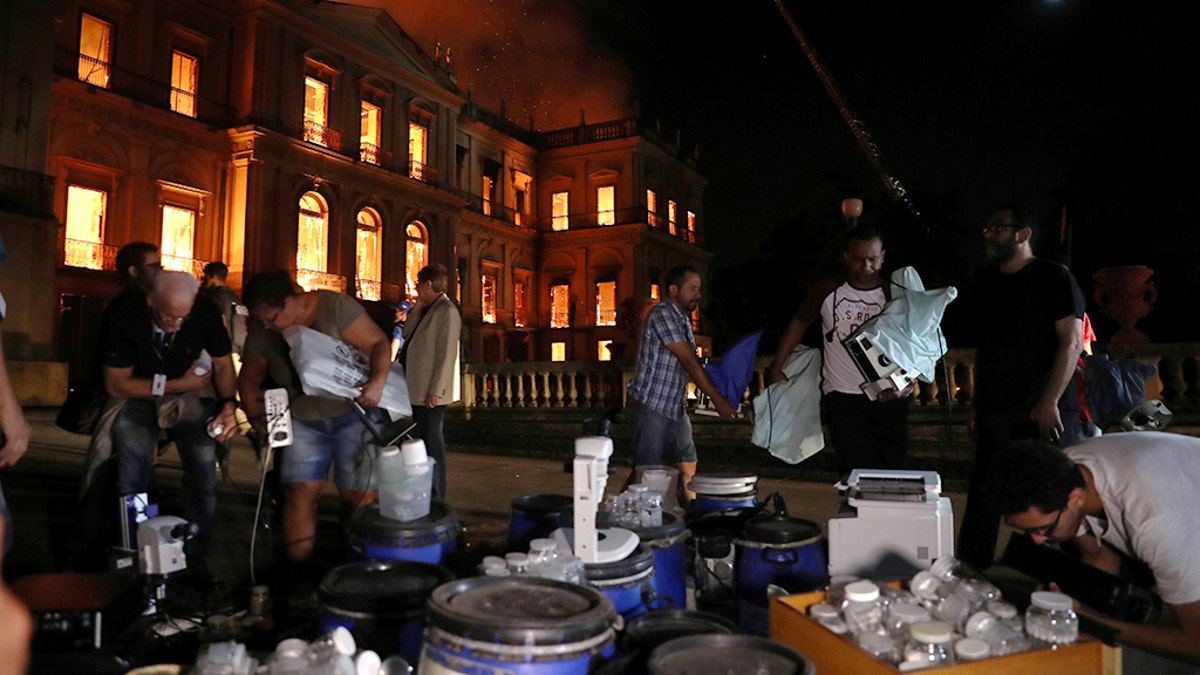
Rescuers tried saving some of the items inside the museum, but many artifacts were presumed lost. (REUTERS/Ricardo Moraes)
The biggest meteorite and a few other notable artifacts survived the catastrophic fire that destroyed the National Museum of Brazil on Sunday.
The Bendegó meteorite, the largest ever found in Brazil, survived the fire, Space.com reported. It is one of approximately a dozen meteorites that were part of the museum's collection, prior to the fire.
The space rock was found near the town of Monte Santo in the Brazilian state of Bahia in 1784, Space.com added. It weighs approximately 11,600 pounds and is made up iron and nickel.
BRAZIL FIREFIGHTERS TRY SAVING RELICES AT 200-YEAR-OLD NATIONAL MUSEUM AFTER MASSIVE BLAZE
According to the museum's description of the meteorite, it was originally supposed to be transported to Brazil's capital, but wound up falling out of the wooden cart which was used to transport it and crashed into a stream. It stayed in the stream for another century, when Brazil Emperor Pedro II had the meteorite relocated to the museum. It has been on display since 1888.
Other items have been recovered, officials said, including bone fragments from a collection, raising hopes that a famed skull might somehow have survived a massive blaze that turned historic and scientific artifacts to ashes.
The firefighters "found fragments of bones in a room where the museum kept many items, including skulls," said Cristiana Serejo, the museum's vice director. "We still have to collect them and take them to the lab to know exactly what they are."
In its collection of about 20 million items, one of the most prized possessions is a skull called Luzia, which is among the oldest fossils ever found in the Americas.
Museum spokesman Marcio Martins noted that the collection contains hundreds of skulls, and all material would first need to be examined by the Federal Police, who are investigating the still-unknown cause of the fire. Experts will then examine them to determine their identity.
Investigators were first allowed to enter the main building Monday, but it is still off-limits to researchers. Instead, some scientists were focusing attention on an annex on the site, where vertebrate specimens were housed. The fire didn't reach the area, but it caused the electricity to fail, threatening some artifacts.
THE LATEST: BRAZIL MUSEUM OFFICIAL SAYS RISKS WERE KNOWN
"We have animals that need to be frozen, and they were rotting without electricity," said Marcelo Wexler, a researcher in the vertebrate department.
Even as efforts turned to searching the rubble, firefighters were still occasionally directing water at the building, where some embers were still burning. Eduardo Rosse, a fire official, said that was normal for a blaze of this size.
Luiz Fernando Dias Duarte, a museum official, said Monday that anything held in the main building was probably destroyed, and Serejo told the G1 news portal that 90 percent of the collection may have been destroyed.
BRAZIL'S NATIONAL MUSEUM, 200 YEARS OLD, GOES UP IN FLAMES
But on Tuesday, she held out some hope, telling journalists that staff members were "reasonably optimistic about finding some more items inside."
She added that UNESCO, the U.N.'s cultural agency, had offered financial and technical assistance. French and Egyptian officials also have offered help. The museum was home to Egyptian artifacts, and Egypt's ministries of foreign affairs and antiquities have expressed concern over the fate of those objects.
With the cause still under investigation, many already have begun to fix blame, saying years of government neglect left the museum underfunded and unsafe.
Roberto Leher, rector of the Federal University of Rio de Janeiro, to which the museum was linked, said it was well known that the building was vulnerable to fire and in need of extensive repair. In fact, the institution had recently secured approval for nearly $5 million for a planned renovation, including an upgrade of the fire-prevention system, but the money had not yet been disbursed.
On Monday, government officials promised $2.4 million to shore up the building and promised to rebuild the museum.
The Associated Press contributed to this report.




















